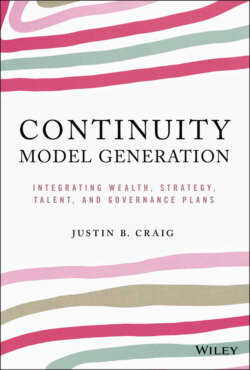Continuity Model Generation

Реклама. ООО «ЛитРес», ИНН: 7719571260.
Оглавление
Justin B. Craig. Continuity Model Generation
Table of Contents
List of Illustrated Tables
List of Illustrations
Guide
Pages
CONTINUITY MODEL GENERATION. Integrating Wealth, Strategy, Talent, and Governance Plans
List of Illustrations
List of Illustrated Tables
List of Configuration Plans
Acknowledgments and Appreciation
Introduction to the Continuity Model Generation
Keystone Meta-Framework
Four Foundational Theoretical Approaches. Agency Theory
Stewardship Theory
Resource-Based View
Principal Cost Theory
Two Complementary Logics
Three Circles Framework
Familial Meta-Framework
The Big Tent Framework
RIPCC Best Practice Dimensions
Four Ps Framework
Four Cs Framework
Individual Meta-Framework
Five Servant Leadership Dimensions
Four Tests Framework
Four Leadership Priorities
Four Exit Strategies
Generational Meta-Framework
Four Ls Framework
Four Ownership Stages
Four Entrepreneurship Principles
Tactical Meta-Framework
Family Enterprise Heterogeneity Frameworks
Four Rs Framework
Four Strategy Dimensions Framework
Fundamental Meta-Framework
Four Trust Dimensions
Five-Stage Life Cycle Framework
Stage One: Existence
Stage Two: Survival
Stage Three: Success
Stage Four: Renewal
Stage Five: Decline
Church and State Framework
Four Innovation Capabilities
Technology Development Capabilities
Business-Driven Capabilities
Part II The Continuity Canvas
Strategy:Strategic Planning for Continuity
Strategic Planning for Continuity I: Collecting and Collating Basic Information
Strategic Planning for Continuity II: Cornerstone Concept Equals a Quadruple-Bottom-Line Scorecard
Financial Perspective
Keystone Meta-Framework: Agency, Owner–Steward, and Manager–Steward
Familial Meta-Framework: Issues are the Same, Perspectives Differ
Individual Meta-Framework: Persuasiveness
Generational Meta-Framework: Affordable Loss
Tactical Meta-Framework: Financial Perspective of the Balanced Scorecard
Fundamental Meta-Framework: Business Equals State
Social Perspective
Keystone Meta-Framework: Social Logic
Familial Meta-Framework: Commitment to Us
Individual Meta-Framework: Organizational Stewardship from the Four Servant Leadership Dimensions
Generational Meta-Framework: Learn Our Family Business
Tactical Meta-Framework: Customer
Fundamental Meta-Framework: Family Equals Church
Environmental Perspective
Keystone Meta-Framework: Resource-Based View
Familial Meta-Framework: Philanthropy Leader
Individual Meta-Framework: Organizational Stewardship
Generational Meta-Framework: Learn to Lead
Tactical Meta-Framework: Innovation and Learning
Fundamental Meta-Framework: Technology Development Capability
Talent Perspective
Keystone Meta-Framework: Principal Cost
Familial Meta-Framework: Community
Individual Meta-Framework: Four Tests Framework
Generational Meta-Framework: Learn Business, Learn Our Family Business
Tactical Meta-Framework: Four Rs Framework
Fundamental Meta-Framework: Four Trust Dimensions Framework, Business-Driven Capabilities
Talent: Successors’ Talent Development Planning for Continuity
Successors’ Talent Development Planning for Continuity I: Collecting and Collating Basic Information
Successors’ Talent Development Planning for Continuity II: Cornerstone Concept Equals Develop an Informed Individual Philosophy of Stewardship
Values – History – Legacy. Keystone Meta-Framework: Stewardship and Resource-Based View
Familial Meta-Framework: A Commitment to Us
Individual Meta-Framework: Altruism
Generational Meta-Framework: Learn our Family Business
Tactical Meta-Framework: The Steward
Fundamental Meta-Framework: Benevolence
Financial Literacy and Value Creation. Keystone Meta-Framework: Economic
Familial Meta-Framework: Big Tent Executive or Employee
Individual Meta-Framework: Self-Imposed Test
Generational Meta-Framework: Affordable Loss
Tactical Meta-Framework: Financial Perspective of the Balanced Scorecard
Fundamental Meta-Framework: Renewal
Governance Role Preparation. Keystone Meta-Framework: Three Circles
Familial Meta-Framework: Business or Family Governor
Individual Meta-Framework: Governor Exit Style
Generational Meta-Framework: Cousin Consortium
Tactical Meta-Framework: The Governor
Fundamental Meta-Framework: Ability and Consistency
Individual Development. Keystone Meta-Framework: Three Circles
Familial Meta-Framework: Four Ps
Individual Meta-Framework: Political Test
Generational Meta-Framework: Learn to Let Go
Tactical Meta-Framework: Four Rs
Fundamental Meta-Framework: Trust Dimensions
Wealth: Asset, Wealth, and Estate Planning for Continuity
Asset, Wealth and Estate Planning for Continuity I: Collecting and Collating Basic Information
Asset, Wealth, and Estate Planning for Continuity II: Cornerstone Concept Equals Produce a Handwritten Individual Legacy Statement
Keystone Meta-Framework
Familial Meta-Framework
Individual Meta-Framework
Generational Meta-Framework
Phase 4: Learning To Let Go Our Business
Tactical Meta-Framework
Fundamental Meta-Framework
Governance: Governance Planning for Continuity
Governance Planning for Continuity I: Collecting and Collating Basic information
Governance Planning for Continuity II: Cornerstone Concept Equals Craft the Family's Governance Philosophy
Business Governance. Keystone Meta-Framework: Four Foundational Theories
Familial Meta-Framework: Business Governor – Family Governor
Individual Meta-Framework: Four Tests Framework
Generational Meta-Framework: Learn Our Family Business
Tactical Meta-Framework: Governance – The Governor
Fundamental Meta-Framework: Renewal – Business-Driven Capabilities
Family Governance. Keystone Meta-Framework: Family Steward
Familial Meta-Framework: Sense of Purpose
Individual Meta-Framework: Political
Generational Meta-Framework: Learn to Lead
Tactical Meta-Framework: Four Rs
Fundamental Meta-Framework: Trust
Ownership Governance. Keystone Meta-Framework: Owner–Stewards
Familial Meta-Framework: Four Ps — Protocols Before Needed
Individual Meta-Framework: Persuasiveness
Generational Meta-Framework: Sibling Partnership
Tactical Meta-Framework: Responsibility
Fundamental Meta-Framework: Church
The Foundation. Keystone Meta-Framework: Social
Familial Meta-Framework: Big Tent—Philanthropy
Individual Meta-Framework: Empathy and Altruism
Generational Meta-Framework: Crazy Quilt
Tactical Meta-Framework: Customer
Fundamental Meta-Framework: Business-Driven Capabilities
Configuration Plan One
Configuration Plan Two
Configuration Plan Three
Configuration Plan Four
Educating Educators
A Program Example. Part One: Frameworks and Meta-Frameworks
Part Two: Four Plans and Cornerstone Concepts for Continuity
Part Three: Presenting Configuration Examples
Part Four: Developing Your Own Continuity Canvas and Cornerstone Concepts
References and Further Readings
References
Further Readings
Index
WILEY END USER LICENSE AGREEMENT
Отрывок из книги
JUSTIN B. CRAIG, PhD
Illustration 2: Agency
.....
Using the RBV framework, Sirmon and Hitt (2003) argued that family businesses evaluate, acquire, shed, bundle, and leverage their resources in ways that are different from those of non-family businesses. In part, these unique resources can emerge from the fact that family members often also act as owners and/or managers. In the family business context, the term “familiness” defines the unique bundle of idiosyncratic resources and capabilities that family firms hold (Habbershon and Williams, 1999). As such, familiness is one of the intangible factors in the RBV (Illustration 4).
Identifying the resource categories that are idiosyncratic is only part of the process. As, if not more important, is understanding what the firm does with resource-related processes or actions. Effectively managing the resources is crucial to creating a competitive advantage and this requires an understanding of how resources are accumulated, bundled, and leveraged. More specifically, Sirmon and colleagues consider resource management to include structuring (i.e. acquiring, accumulating, and divesting) the portfolio of resources, bundling (i.e. stabilizing, enriching, and pioneering) resources to build capabilities, and leveraging (i.e. mobilizing, coordinating, and deploying) capabilities in the marketplace. The synchronization of these processes is important to create value and, in the context of this conversation, contribute optimally to continuity.
.....